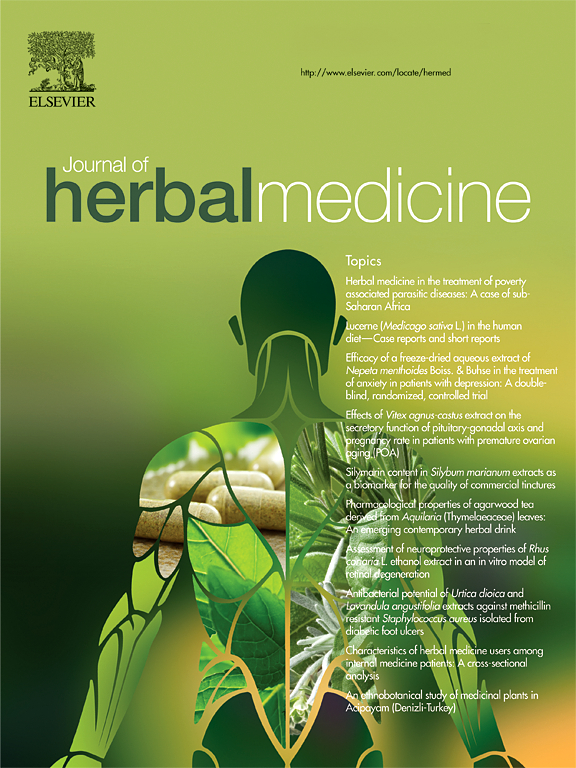Multi-target mechanism of Physalis angulata to treat malaria based on network pharmacology and molecular docking
IF 1.9
4区 医学
Q2 INTEGRATIVE & COMPLEMENTARY MEDICINE
引用次数: 0
Abstract
Introduction
Antimalarial drug resistance, such as artemisinin partial resistance, has become a major concern in malaria eradication. Thus, the development of new alternatives for malaria treatment is needed. Medicinal plants used by people in endemic areas, such as Physalis angulata, need to be studied for their claimed efficacy to treat malaria.
Methods
In this study, we used a network pharmacology approach utilising several databases (KNApSAck, GeneCards, SwissADME, Pharmmapper, SwissTargetPrediction, SuperPred, STRING-DB, DAVID) to predict the multi-mechanism of P. angulata to alleviate malaria, as confirmed by molecular docking.
Results
The result revealed that 25 compounds of P. angulata interact with 22 malaria-related targets, where molecular docking performed for compounds and targets associated with malaria pathways verified that withangulatin F showed a good binding affinity with ICAM1, VCAM1, and SELE, physagulin A with IL1B, physagulin J with TNF, and physalin V with TLR4.
Conclusion
We predict that P. angulata alleviates malaria through several mechanisms, primarily by regulating the inflammatory response. This mechanism reduces excess proinflammatory cytokines like TNF and IL1B, leads to reduced levels of adhesion molecules, and ultimately reduces or prevents the severity of malaria.

基于网络药理学和分子对接的角Physalis治疗疟疾多靶点机制研究
抗疟药物耐药性,如青蒿素部分耐药性,已成为消除疟疾的一个主要问题。因此,需要开发新的疟疾治疗方法。在疟疾流行地区人们使用的药用植物,如Physalis angulata,需要对其声称的治疗疟疾的功效进行研究。方法采用网络药理学方法,利用KNApSAck、GeneCards、SwissADME、Pharmmapper、SwissTargetPrediction、SuperPred、STRING-DB、DAVID等多个数据库,预测角蒿缓解疟疾的多机制,并进行分子对接验证。结果发现,角田菁中有25个化合物与22个疟疾相关靶点相互作用,其中对与疟疾通路相关的化合物和靶点进行了分子对接,证实了withangulatin F与ICAM1、VCAM1和SELE具有良好的结合亲和力,physagulin a与IL1B、physagulin J与TNF、physalin V与TLR4具有良好的结合亲和力。结论我们预测角田葵通过多种机制缓解疟疾,主要是通过调节炎症反应。这一机制减少了过量的促炎细胞因子,如TNF和IL1B,导致粘附分子水平降低,最终降低或预防疟疾的严重程度。
本文章由计算机程序翻译,如有差异,请以英文原文为准。
求助全文
约1分钟内获得全文
求助全文
来源期刊

Journal of Herbal Medicine
INTEGRATIVE & COMPLEMENTARY MEDICINE-
CiteScore
3.90
自引率
0.00%
发文量
94
期刊介绍:
The Journal of Herbal Medicine, the official journal of the National Institute of Medical Herbalists, is a peer reviewed journal which aims to serve its readers as an authoritative resource on the profession and practice of herbal medicine. The content areas of the journal reflect the interests of Medical Herbalists and other health professionals interested in the clinical and professional application of botanical medicines. The objective is to strengthen the research and educational base of herbal medicine with research papers in the form of case studies, original research articles and reviews, monographs, clinical trials and relevant in vitro studies. It also publishes policy statements, opinion pieces, book reviews, conference proceedings and profession related information such as pharmacovigilance reports providing an information source for not only the Herbal Practitioner but any Health professional with an interest in phytotherapy.
 求助内容:
求助内容: 应助结果提醒方式:
应助结果提醒方式:


